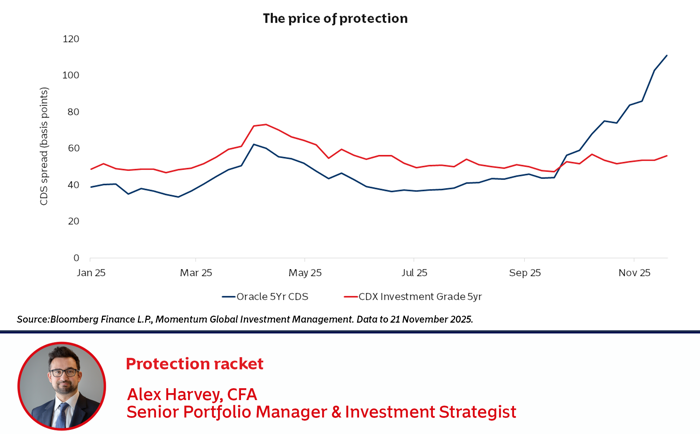
What this chart shows
The chart shows in blue the five-year CDS (credit default swap) for Oracle Corp, the US software company. CDS is a type of OTC (‘over the counter’) derivative and is used primarily by sophisticated investors to take a long or short view on a credit, in the same way an equity investor might use equity futures to take a directional view on a stock or equity index. They are relatively liquid for large benchmark issuers and when traded in size can often be more liquid than the underlying issuer’s bonds. Oracle’s current CDS ‘spread’ or price – 110 basis points – refers to the cost of insuring against default on the company’s debt. As such it would cost $110,000 per annum to protect $10m nominal of the company’s bonds. The orange line shows the equivalent cost of insurance for an equally weighted basket of the 125 most liquid US investment grade issuers; this is the 5yr CDX IG index. The CDX ‘spread’ has remained relatively flat over the last two months whilst that of Oracle – which itself is investment grade rated - has gone up almost 3x. As the spread goes up – or widens – the cost of insurance gets more expensive. Someone who went long and bought protection on Oracle at 40 in August can close out their position today at a profit – effectively selling on the insurance contract they took out to someone else at a higher price.
Why this is important
Concerns have started to be raised recently around whether there is a bubble in AI related stocks. Their prices had until recently continued to climb ever higher against a backdrop of vastly increasing capital expenditure, to a level where analysts were starting to question the future level of return on invested capital. No one is saying that significant investment is not going to be required in the build out of data centres and IT infrastructure, but consensus increasingly seems to be that the winners in this IT arms race will win big, whilst others stand to lose. As these concerns have grown, and with Oracle perceived to be a weaker name amongst this cohort, some market participants that are able to undertake CDS transactions have used Oracle’s CDS as a hedge against this AI bubble risk. As demand for protection has grown, so the price of it has risen, to a level that probably does not reflect the true underlying credit default risk associated with the company. It is important as it reminds us that not everyone thinks big tech is a one w-AI trade.
Earnings, fiscal policies, and geopolitical tensions are collectively shaping markets, highlighting the need for investors to navigate both economic signals and rising global risks.

-
Nvidia reported blow-out Q3 (FY26) revenue and raised guidance; the strong data calmed AI-bubble jitters and lifted chip and tech sentiment across markets.
-
Berkshire Hathaway disclosed a roughly $4.9bn stake in Alphabet, sending Alphabet shares higher and prompting discussion about more value-style buying into big tech.
-
US jobs data (delayed by the shutdown) showed solid payroll gains for September but a higher unemployment rate (4.4% - its highest since October 2021), muddying the Federal Reserve outlook for further rate moves.
-
Markets remained watchful ahead of central-bank signalling and major tech earnings (Nvidia was the focal point) - volatility rose around AI-sector narratives.

-
UK Chancellor Rachel Reeves framed the upcoming budget as a “grip” on the cost of living while reports suggested a mix of freezes, targeted levies and potential tax measures to plug fiscal gaps due.
-
The Defence Ministry confirmed the Royal Navy intercepted two Russian ships from the English Channel and Scotland the week before. This incident highlights a notable 30 per cent increase in Russian naval activity around UK waters over the past two years.
-
Domestic economic datapoints showed early signs of softening in labour and consumer activity (jobless rate drift and cooled spending) that increased market sensitivity to fiscal choices.
-
Market expectations are shifting toward possible rate cuts by Bank of England (BoE). For example, some futures are indicating ~80% chance of a cut at the December meeting.

-
EU institutions reached a provisional deal to harmonise insolvency rules across member states - aimed at improving cross-border recoveries and capital-market integration.
-
The European Commission nudged growth forecasts upward for 2025 even as member states debate steps to boost investment and financial stability.
-
Financial-sector and regulatory chatter intensified (ESMA / ECB supervision notes) as the bloc seeks deeper capital-market reforms to compete globally.
-
Political friction (energy, trade frictions with third countries, and security/sabotage concerns in Central Europe) kept geopolitical risk in investors’ peripheral scan.

-
Chinese equity markets faced renewed selling pressure through the week as growth concerns and geopolitics weighed on investor sentiment.
-
Japanese relations with China deteriorated sharply following Japan’s Prime Minister Sanae Takaichi’s remarks on Taiwan; Beijing retaliated with travel warnings and coastguard moves, driving a sell-off in Japanese tourism, retail and hospitality stocks.
-
The UN Security Council passed Resolution 2803, authorising a multinational “International Stabilisation Force” in Gaza, with Qatar urging rapid implementation and full Israeli withdrawal.
-
At the G20 summit in Johannesburg, leaders adopted a 122 point declaration (despite a US boycott) that emphasised debt relief, climate finance, and a “just, lasting peace” for conflict zones including Ukraine and Palestine - signalling a G20 shift toward GlobalSouth priorities and multilateral reform.
